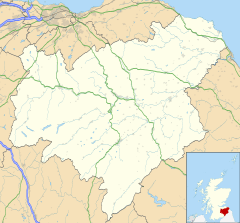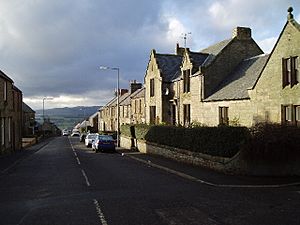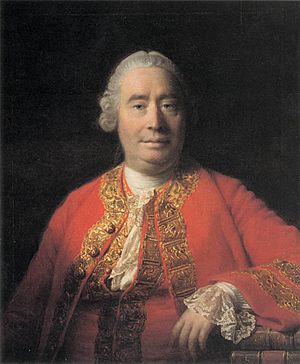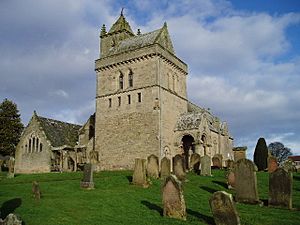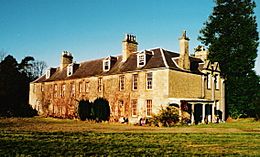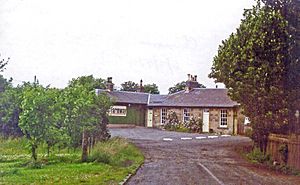Chirnside facts for kids
Quick facts for kids Chirnside |
|
|---|---|
 The Waterloo Inn, which dates to the 1820s |
|
| Population | 1,450 (2020) |
| OS grid reference | NT8656 |
| Council area | |
| Country | Scotland |
| Sovereign state | United Kingdom |
| Post town | Duns |
| Postcode district | TD11 |
| Dialling code | 01890 |
| Police | Lothian and Borders |
| Fire | Lothian and Borders |
| Ambulance | Scottish |
| EU Parliament | Scotland |
| UK Parliament |
|
| Scottish Parliament | |
Chirnside is a village located on a hillside in Berwickshire, Scotland. It is about 9 kilometres west of Berwick-upon-Tweed. It is also about 7 kilometres east of Duns.
Contents
Chirnside's Historic Church
The main church in Chirnside has a long history. It was first built in the 12th century. Over the years, it has been rebuilt and repaired many times. Major changes happened in 1878 and 1907. Even with all these changes, you can still see parts of the original church. Look for the old Norman doorway at the west end. It has a special zig-zag pattern.
Old Dovecots in Chirnside
A "doocot" is a special building where pigeons or doves were kept.
- The Ninewells Doocot is a round, beehive-shaped doocot from the 16th century. You can find it in a garden near the church.
- The Whitehall Doocot is also nearby. It is a rectangular building with two rooms. It has a sloped roof made of stone.
Whitehall Estate
Below Chirnside was the Whitehall estate. It once had a beautiful manor house. This house was built in the Georgian style. It had special Palladian windows and a music room with fancy Italian plasterwork.
The Hall of Dunglass family used to own Whitehall. Later, in the 1800s, it passed to the Mitchell-Innes family. They owned it until the 1980s. Sadly, the manor house became empty and was in danger of falling apart. It was taken down in 2015.
Ninewells House and David Hume
Ninewells gets its name from the many springs that flow from the hillside. These springs feed into the Whiteadder Water.
This estate was home to the Home (later Hume) family for many years. It was the childhood home of David Hume (1711–1776). He was a very famous philosopher, economist, and writer. He also spent his summers here later in life.
The original Ninewells house was rebuilt in 1839–1841. It was designed in the Tudor style. However, this house was also taken down in 1954.
During World War Two, Ninewells House was used as a place for people who had to leave their homes. Some Polish soldiers stayed there. It was also used as a prisoner of war camp for a time around 1942–1943.
Today, the Ninewells Walled Garden still stands. You can find it on the A6437 road south of the village. It dates back to the early 19th century.
Billie Castle Ruins
About 2 kilometres north of Chirnside are the remains of Billie Castle. This castle belonged to the Renton family. It was attacked many times in the 16th century.
In 1544, the castle was destroyed during a conflict called The Rough Wooing. It was later repaired but then left empty in the 18th century. By 1834, it was already a ruin. The castle likely had a tall tower house with walls and a moat. You can also see the remains of old lime kilns nearby.
Chirnside Primary School
Chirnside Primary School was built in 1937. It was designed by architects Messrs Reid & Forbes. The school is built into a hillside. Because it is white, you can see it from far away.
Chirnside Bridge Paper Mill
The Chirnside Bridge Paper Mill is a large factory today. It has been around for a long time. It was first built in 1842 and 1857. The main office building was built in the Italianate style. It was originally a house for the mill's owner. There was an even older mill on this site. The small building that was once the porter's lodge is very old. It is an octagonal (eight-sided) building in the Gothic style.
Berwickshire Railway History
Chirnside once had its own railway station. It was part of the North British Railway's Berwickshire Railway. This line opened in 1863. It connected Reston to Earlston.
A large railway bridge was built over the Whiteadder Water in 1863. It had five rounded arches. This bridge carried the railway line.
Chirnside Railway Station stopped taking passengers on September 10, 1951. Freight trains continued until July 19, 1965. The old station building is still there. It is now used to store farm supplies.
Chirnside's Unique Dialect
Chirnside has a special way of speaking the Scots language. A Swiss expert named Paul Wettstein studied this dialect. He published his findings in 1942. In this dialect, Chirnside is pronounced "Churn-side."
Sports in Chirnside
The local football team is Chirnside F.C.. They play in the Border Amateur league. The team has played in the Scottish Cup nine times between 1935 and 1966.
Famous People from Chirnside
- David Hume, the famous Scottish Enlightenment philosopher, lived in Ninewells House (see above). His nephew, also named David Hume, was a well-known Scottish lawyer. He was baptised in Chirnside in 1757.
- Chirnside is the final resting place of Jim Clark. He was a world champion Formula One racing-car driver. He also started the Border Reivers (racing team). Near the churchyard where he is buried, there is a memorial plaque and a clock. The Jim Clark Motorsport Museum is in Duns.
- Joelle Murray, a Scottish international football player for Hibs, is from the village.
- Liam Craig, a former football player, is also from Chirnside.


